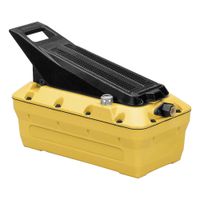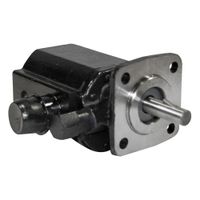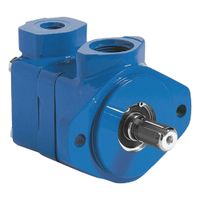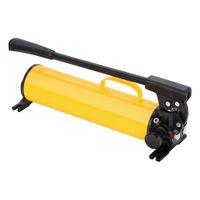Call +(254) 703 030 000 / 751 483 999 / 721 704 777
- Home
- Hydraulics
- Hydraulic Pumps
.....Read More
Frequently Asked Questions
What is a hydraulic pump and how does it work?
A hydraulic pump is a mechanical device that converts mechanical energy into hydraulic energy. It works by creating a flow of fluid, typically oil, which is then used to transmit power in hydraulic systems. The pump operates on the principle of Pascal's law, which states that pressure applied to an enclosed fluid is transmitted undiminished to every portion of the fluid and the walls of the containing vessel.
Here's a simplified explanation of how it works:1. **Suction:** As the pump's internal components (e.g., gears, vanes, or pistons) move, they create a low-pressure area, drawing fluid from the reservoir into the pump's inlet.
2. **Pressurization:** The fluid is then trapped and forced into a smaller volume, increasing its pressure.
3. **Discharge:** This high-pressure fluid is then discharged from the pump's outlet, typically into a hydraulic circuit where it can power actuators, cylinders, or motors to perform work.Different types of hydraulic pumps, such as gear pumps, vane pumps, and piston pumps, achieve this process through various mechanisms, but the fundamental principle of converting mechanical input into fluid power remains the same.
What are the different types of hydraulic pumps?
Hydraulic pumps are mechanical devices that convert mechanical energy into hydraulic energy. They achieve this by pushing fluid from a reservoir into a hydraulic system, generating flow and pressure. Different types of hydraulic pumps are designed for various applications, offering unique advantages in terms of efficiency, pressure capability, and flow control.
Common types include: * **Gear Pumps:** These are positive displacement pumps that use meshing gears to pump fluid. They are simple, economical, and commonly used in low- to medium-pressure applications, such as power steering systems and agricultural machinery.
* **Vane Pumps:** Vane pumps use a rotor with movable vanes to create chambers that expand and contract, drawing in and expelling fluid. They are known for their quiet operation, good volumetric efficiency, and ability to handle moderate pressures, often found in industrial applications.
* **Piston Pumps:** These pumps utilize reciprocating pistons to move fluid. They can be axial (pistons parallel to the drive shaft) or radial (pistons perpendicular to the drive shaft). Piston pumps are highly efficient, capable of handling very high pressures, and offer variable displacement control, making them suitable for heavy-duty industrial machinery, construction equipment, and aerospace applications.
* **Screw Pumps:** Screw pumps use one or more rotating screws to move fluid along an axis. They are known for their smooth, pulsation-free flow, low noise levels, and ability to handle viscous fluids. They are often used in lubrication systems and chemical processing.The selection of a hydraulic pump depends on factors such as required flow rate, operating pressure, fluid viscosity, efficiency needs, and cost considerations.
How do you choose the right hydraulic pump for a specific application?
Choosing the right hydraulic pump involves considering several factors: * **Application Requirements:** Understand the specific needs of the system, including required pressure, flow rate, and duty cycle.
* **Pump Type:** Different pumps (gear, vane, piston) offer varying efficiencies, pressure capabilities, and noise levels. Gear pumps are simple and economical for lower pressures; vane pumps offer good efficiency and quiet operation; piston pumps are highly efficient and suitable for high pressures and variable flow.
* **System Pressure and Flow:** Match the pump's maximum pressure and flow rate to the application's demands, ensuring it can handle peak loads without overworking.
* **Fluid Compatibility:** Ensure the pump is compatible with the hydraulic fluid being used, considering viscosity, temperature range, and additives.
* **Operating Environment:** Account for factors like temperature, contamination, and vibration, which can impact pump longevity and performance.
* **Efficiency:** Consider the pump's volumetric and overall efficiency to minimize energy consumption and heat generation.
* **Cost and Maintenance:** Evaluate the initial cost, expected lifespan, and ease of maintenance.
* **Noise Levels:** In certain applications, noise reduction may be a critical factor.By carefully assessing these aspects, you can select a hydraulic pump that optimizes system performance, reliability, and cost-effectiveness.
What are the advantages of using an air-operated hydraulic pump?
Air-operated hydraulic pumps offer several advantages due to their design and operation. They are inherently safe for use in hazardous environments because they do not require electricity to operate, reducing the risk of sparks or electrical shorts. This makes them ideal for applications involving flammable liquids or gases. Additionally, these pumps are known for their compact size and portability, making them easy to move and deploy in various work settings.
Another key advantage is their durability and low maintenance requirements. Air-operated pumps typically have fewer moving parts compared to electric pumps, which translates to less wear and tear and a longer operational lifespan. They are also capable of holding pressure without consuming continuous energy, making them energy-efficient for applications requiring sustained pressure. Furthermore, the air-driven nature allows for easy control of pressure and flow, often providing precise and consistent output for various hydraulic tools and systems.
How do electric-operated hydraulic pumps differ from manual-operated ones?
Electric-operated hydraulic pumps and manual-operated hydraulic pumps differ primarily in their power source, efficiency, and application. Electric pumps use an electric motor to power the hydraulic system, providing consistent, high-pressure fluid flow without manual effort. This makes them ideal for tasks requiring sustained operation, high force, or repetitive actions, as they significantly reduce operator fatigue and increase speed. They are commonly used in industrial settings, large-scale construction, and heavy machinery, offering precise control and higher output.
In contrast, manual-operated hydraulic pumps rely on human power to generate hydraulic pressure, typically through a lever or hand pump. While simpler in design and often more portable, they require significant physical effort, are slower, and produce lower hydraulic force compared to electric pumps. Manual pumps are best suited for intermittent, low-force applications where electricity is unavailable or impractical, such as small lifting jacks, basic repair work, or emergency situations. The choice between the two depends on the required power, speed, operational frequency, and available resources.
What maintenance is required for hydraulic pumps?
Regular maintenance is crucial for the optimal performance and longevity of hydraulic pumps. Key aspects include routine fluid checks for contamination and proper levels, as contaminated or low fluid can lead to cavitation and wear. Filters should be inspected and replaced regularly to prevent particle buildup. Temperature monitoring is also important, as overheating can degrade the fluid and seals. Additionally, inspect hoses, fittings, and seals for leaks or damage, and check for unusual noises or vibrations which may indicate internal issues. Lubrication of moving parts, where applicable, is also essential. Adhering to the manufacturer's recommended service intervals and using the correct type of hydraulic fluid are vital for preventing costly breakdowns and ensuring efficient operation.
What are the common problems and troubleshooting tips for hydraulic pumps?
Common problems with hydraulic pumps include cavitation, aeration, fluid contamination, and excessive noise or vibration. Cavitation occurs when air bubbles form and collapse in the fluid, leading to erosion and damage. Aeration is the presence of air mixed into the hydraulic fluid, which can cause spongy operation and reduced efficiency. Contaminated fluid, often due to dirt or debris, can lead to wear and tear on pump components and system malfunctions. Excessive noise or vibration can indicate underlying issues such as misaligned components, worn bearings, or improper fluid viscosity.
Troubleshooting tips often involve inspecting the fluid level and quality, checking for air leaks in the suction line, ensuring proper filtration, and examining pump components for wear or damage. Regular maintenance, including fluid changes and filter replacements, is crucial for preventing these issues and ensuring the longevity and efficient operation of hydraulic pumps.
How do hydraulic gear pumps compare to vane pumps?
Hydraulic gear pumps and vane pumps both convert mechanical power into hydraulic energy, but they differ significantly in their operation, efficiency, and applications.
Gear pumps, typically positive displacement pumps, use meshing gears to draw fluid into the inlet and force it out the outlet. They are known for their simplicity, robustness, and ability to handle contaminated fluids. Internal gear pumps have a smaller gear rotating inside a larger one, while external gear pumps use two external gears. Gear pumps are generally less efficient than vane pumps at higher pressures and have a fixed displacement.
Vane pumps, also positive displacement pumps, use a rotor with vanes that slide in and out of slots. As the rotor turns, centrifugal force or springs push the vanes against the pump housing, creating chambers that expand to draw in fluid and contract to expel it. Vane pumps are often more efficient than gear pumps, especially at lower pressures, and can be designed for variable displacement, allowing for flow control. They also tend to operate more quietly and produce less pulsation. However, they are more sensitive to fluid contamination and can wear out more quickly if the fluid is not clean.
In summary, gear pumps are rugged and cost-effective, suitable for applications where high efficiency and low noise are not critical, or where fluid contamination is a concern. Vane pumps offer higher efficiency, quieter operation, and often variable displacement, making them suitable for applications requiring precise flow control and lower noise levels, provided the hydraulic fluid is kept clean.
What are the benefits of using a hydraulic piston pump?
Hydraulic piston pumps offer several significant advantages in various industrial and mobile applications, primarily due to their efficiency, durability, and control capabilities.
One key benefit is their high volumetric efficiency. Piston pumps can maintain high efficiency even under high pressures, leading to less energy waste and lower operating costs. This is because their internal components are designed to minimize leakage, ensuring that more of the input power is converted into hydraulic output.
Another advantage is their ability to operate at very high pressures. This makes them suitable for heavy-duty applications that require substantial force, such as construction equipment, injection molding machines, and metal forming presses. The robust construction of piston pumps allows them to withstand these extreme conditions without compromising performance or longevity.
Furthermore, piston pumps offer excellent control over flow and pressure. Many piston pumps are variable displacement, meaning their output flow can be adjusted precisely. This feature, often achieved through swashplate or bent-axis designs, allows for fine-tuning of system performance, leading to more accurate and responsive operations. This level of control is crucial for applications requiring precise movements or variable speed.
Their durability and long lifespan are also notable benefits. Constructed with high-quality materials and precision engineering, piston pumps are designed to withstand continuous operation in demanding environments. This reduces downtime for maintenance and replacements, contributing to overall operational efficiency and cost savings.
In summary, the benefits of hydraulic piston pumps—including high efficiency, high-pressure capability, precise control, and durability—make them a preferred choice for a wide range of demanding hydraulic systems.
How do hydraulic PTO pumps function and what are their applications?
Hydraulic PTO (Power Take-Off) pumps convert mechanical power from a vehicle's engine or transmission into hydraulic power, which is then used to operate various implements and machinery. They achieve this by taking rotational energy from the PTO shaft and using it to drive a pump, typically a gear pump or piston pump. This pump pressurizes hydraulic fluid, which is then directed through hoses and valves to actuators like hydraulic cylinders or motors on the attached equipment.
Their function relies on a few key principles: * **Power Transfer:** The PTO provides the mechanical input, usually through a spline shaft, directly connected to the vehicle's drivetrain.
* **Fluid Pressurization:** The pump's internal components create a vacuum to draw fluid from a reservoir and then push it into a confined space, building pressure.
* **System Integration:** The pressurized fluid is routed to the equipment, where it performs work by moving components. Return lines bring the fluid back to the reservoir.Applications of hydraulic PTO pumps are extensive, particularly in agriculture, construction, and transportation: * **Agriculture:** Powering front-end loaders, plows, bailers, sprayers, and various towed implements.
* **Construction:** Operating excavators, cranes, dump truck hoists, concrete mixers, and compactors.
* **Forestry:** Driving log splitters, chippers, and grapples.
* **Utility and Municipal:** Used in snowplows, salt spreaders, refuse collection vehicles, and aerial lift trucks.
* **Marine:** Operating winches, steering systems, and other deck machinery on boats and ships.In essence, hydraulic PTO pumps are crucial for extending the utility of vehicles, enabling them to power a wide range of specialized equipment that requires hydraulic force.







